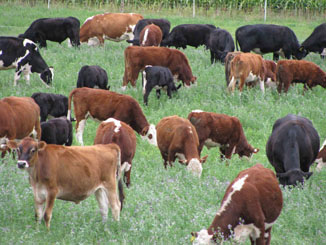MIG (Management Intensive Grazing)

Our grazing progam is called rotational grazing by some and Management Intensive Grazing (MIG) by others. We graze our sheep and cattle on fresh pasture daily, moving the cattle to fresh pasture 2 or 3 times a day while the sheep get fresh pasture daily. Our goal with all our animals are to give them fresh pasture so they will eat well and grow to their greatest potential without grains or adding hormones to their diets or bodies. By moving the animals with such a great frequency we increase their consumption although it's rather labor intensive putting the portable fences up and taking them down frequently throughout the growing season. Sometimes, I believe it would more accurately be named labor intensive grazing instead of management intensive grazing because of the high labor input.
Our pastures are a mix of legumes and grasses, some of which we planted and others which thrive naturally in our area. The pastures started out as alfalfa fields a long time ago and we interseeded clover and various grasses including ryegrass and meadow fescue. Crabgrass, dandelion and other naturally occuring grasses have been filling in the pastures in some of the weak spots which were drowned out or lost to winterkill. Our goal is to help nature to take care of our pastures, not get in the way of nature.
To say our beef and lamb is grass-fed only begins to tell our story since calling our beef and lamb grass-finished more accurately describes the products we bring to the market place. Being grass-finished provides marbling througout the meat so our grass-finished beef and lamb will be both flavorful and tender to our buyers. When we have the opportunity to provide the entry for a meal we want the chefs to know that we have done our job right to get them a high end product at a fair price, which they can be proud to set at their table.
